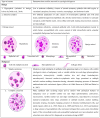Cytological Grading of Breast Tumors-The Human and Canine Perspective
- PMID: 31508437
- PMCID: PMC6718613
- DOI: 10.3389/fvets.2019.00283
Cytological Grading of Breast Tumors-The Human and Canine Perspective
Abstract
Human breast cancers (HBCs) are one of the leading causes of global cancer death among women. Domesticated canines are the most affected domestic species with a prevalence rate of breast cancer more than three times in women. While the human cancer patients receive substantial diagnostic and treatment facilities, inadequacy in canine cancer care, calls for greater attention. Fine Needle Aspiration Cytology (FNAC) is comparatively simple, quick, and easily reproducible technique, which aids in pre-surgical diagnosis. In humans, FNAC has a standard protocol, the Robinson's grading system, which has high correlation with the established histological grading system of Scarff Bloom- Richardson. However, Canine Mammary Tumors (CMTs), which are known to be similar to HBCs in biological behavior and gene expressions, still bank on the histopathological methods for diagnostic purposes. This review sheds light on various factors that could be considered for developing a standard FNAC technique for CMT grading and analyzes its future perspectives.
Keywords: breast; canine; cytology; grading; human; tumor.
Figures
Similar articles
-
Diagnostic efficacy of smear cytology and Robinson's cytological grading of canine mammary tumors with respect to histopathology, cytomorphometry, metastases and overall survival.PLoS One. 2018 Jan 23;13(1):e0191595. doi: 10.1371/journal.pone.0191595. eCollection 2018. PLoS One. 2018. PMID: 29360854 Free PMC article.
-
Correlative Evaluation of Seven Cytological 3-Tier Grading Systems of Breast Carcinoma with the Standard Histological Grading: A 4 and ½ Year Study.Acta Cytol. 2023;67(5):482-492. doi: 10.1159/000531463. Epub 2023 Jun 16. Acta Cytol. 2023. PMID: 37331335
-
Correlative Study of Cytological Features in Grading of Invasive Breast Carcinoma.J Cytol. 2018 Jul-Sep;35(3):149-152. doi: 10.4103/JOC.JOC_2_18. J Cytol. 2018. PMID: 30089943 Free PMC article.
-
Grading systems in the cytological diagnosis of breast cancer: a review.J Cancer Res Ther. 2014 Oct-Dec;10(4):839-45. doi: 10.4103/0973-1482.140979. J Cancer Res Ther. 2014. PMID: 25579516 Review.
-
[Needle aspiration cytology of the breast: current perspective on the role in diagnosis and management].Acta Med Croatica. 2008 Oct;62(4):391-401. Acta Med Croatica. 2008. PMID: 19205416 Review. Croatian.
Cited by
-
Proteomic Analysis Identifies FNDC1, A1BG, and Antigen Processing Proteins Associated with Tumor Heterogeneity and Malignancy in a Canine Model of Breast Cancer.Cancers (Basel). 2021 Nov 24;13(23):5901. doi: 10.3390/cancers13235901. Cancers (Basel). 2021. PMID: 34885011 Free PMC article.
-
Canine multiple primary tumours: Mammary tubular carcinoma, uterine leiomyosarcoma, and facial sebaceous epithelioma.Vet Med (Praha). 2024 Mar 26;69(3):94-98. doi: 10.17221/103/2023-VETMED. eCollection 2024 Mar. Vet Med (Praha). 2024. PMID: 38623156 Free PMC article.
-
Multiplexed immunoassay for a serum autoantibody biomarker panel in diagnostic and prognostic prediction of canine mammary tumors.Vet Q. 2025 Dec;45(1):1-12. doi: 10.1080/01652176.2024.2435978. Epub 2024 Dec 6. Vet Q. 2025. PMID: 39639821 Free PMC article.
-
The Importance of Ultrasonography in the Evaluation of Mammary Tumors in Bitches.Animals (Basel). 2023 May 24;13(11):1742. doi: 10.3390/ani13111742. Animals (Basel). 2023. PMID: 37889644 Free PMC article. Review.
-
The Novel Diagnostic Techniques and Biomarkers of Canine Mammary Tumors.Vet Sci. 2022 Sep 26;9(10):526. doi: 10.3390/vetsci9100526. Vet Sci. 2022. PMID: 36288138 Free PMC article. Review.
References
Publication types
LinkOut - more resources
Full Text Sources



